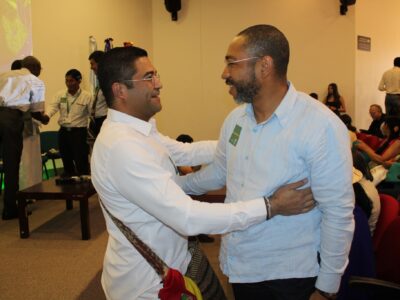
ACDI/VOCA has a growing portfolio of market systems development projects that engage with the private sector, industry chambers, and market research institutes using integrated partnership funds. These transformative partnerships are paying off in their ability to not only create systemic change in economic markets but also meet global development objectives. While coinvesting in shared development goals, our partnerships have generated more than $753 million in sales and leveraged nearly $1.6 billion. In this ongoing blog series, we’ll explore themes around engaging the private sector and share insights from peer learning exchanges with leaders from four ACDI/VOCA-led market systems development projects in Bangladesh, Honduras, Myanmar, and Kyrgyzstan, all of which operate partnership funds.
In the second half of the conversation between four of our market systems development projects, the teams reflected on the various aspects of partnership fund design and management and the role these funds play in creating broader market systems change. The conversation resulted in a number of best practices for creating partnerships and designing funds.
Designing Grant Funds to Achieve Systemic Change
The idea you are supporting should be systemic. Rather than supporting partnerships that maintain the status quo, we must be intentional about calls for co-creation and directing partners to invest in solutions that address specific market system change objectives. Conducting a market systems analysis that informs the partnership strategy — supplemented with secondary research that informs the design of a solicitation — will ensure alignment with the project’s broader strategy and create incentives for firms to target rural producers. Shifting from using Requests for Proposals to Annual Program Statements can also provide more flexibility and avoid disclosing the total funding amount available or number of partners supported. Though there’s no hard-and-fast rule, this allows projects to engage with firms tactfully.
Right-size the investment to achieve optimal impact. Giving less money to the private sector is not necessarily synonymous with sustainability; it’s about investing optimally to have the most impact. It’s also about finding the “sweet spot” between what is most strategic and catalytic to fund and what we cannot fund, such as the day-to-day operations of a business or anything that doesn’t directly relate to the pilot tech or business model. The level of support should be adjusted based on the company’s capacity and ability to achieve the intended outcomes of a partnership.
“Multiple investments to different companies in the same sector can result in increased competition or cooperation.”
— Hiqmet Demiraj, Chief Of Party of the USAID Enterprise Competitiveness Project in the Kyrgyz Republic
Doubling down to create spillover. Spillover impacts and bringing in other firms, such as financial institutions, into the sector can be important as industries or sectors begin to strengthen. The key is to focus first on early adopters and then late-stage adopters who begin to see the value in targeting a particular market segment.
Be intentional about the inclusion of women and youth during co-creation and co-design. Inclusion can be built into the project’s evaluation criteria as well as the partner’s business case, though the business case for engaging more women and youth is not always immediately clear. ACDI/VOCA’s Gender Review Checklist and tools prompt reflection and discussion on how gender and social inclusion have been integrated into a partnership agreement.
“Co-creation is a great opportunity to influence companies’ behavior toward inclusion that aligns with their overall market-based incentives.”
— Sami SAran, Technical Lead, USAID Feed the Future Bangladesh Rice and Diversified Crops Activity (RDC)
Systems change requires constant re-innovation and re-configuration. The biggest risk to partnerships for systemic change is strategy bias — being stuck in what has worked before — and investing in the same ideas. But true systems change requires a willingness to think differently and test new ideas, which can require a higher tolerance for risk for both the donor and the private sector partner.
What Does All This Mean, and Where Does It Leave Us?
While we don’t have all the answers to designing grant funds for market change, having our projects share their experiences, engage in tactful debate, and propose potential solutions adds to our learning and improvement. The common sentiment coming out of these peer learning exchanges was the importance of grant funds to strengthen markets and improve the lives of people who need access to critical technologies and services the most.
Coming Soon in the Engaging the Private Sector Series
Be on the lookout for the next blog in our series on private sector engagement exploring how to manage partnership funds to achieve market change. Are you a market systems development practitioner? How have your projects used grant funds to achieve market change? What experiences above can you relate to, or are there others you can share?
Read the first blog in this series, “Delivering on the Hype of Transformational Partnerships,” published March 15, 2021.
Comments






